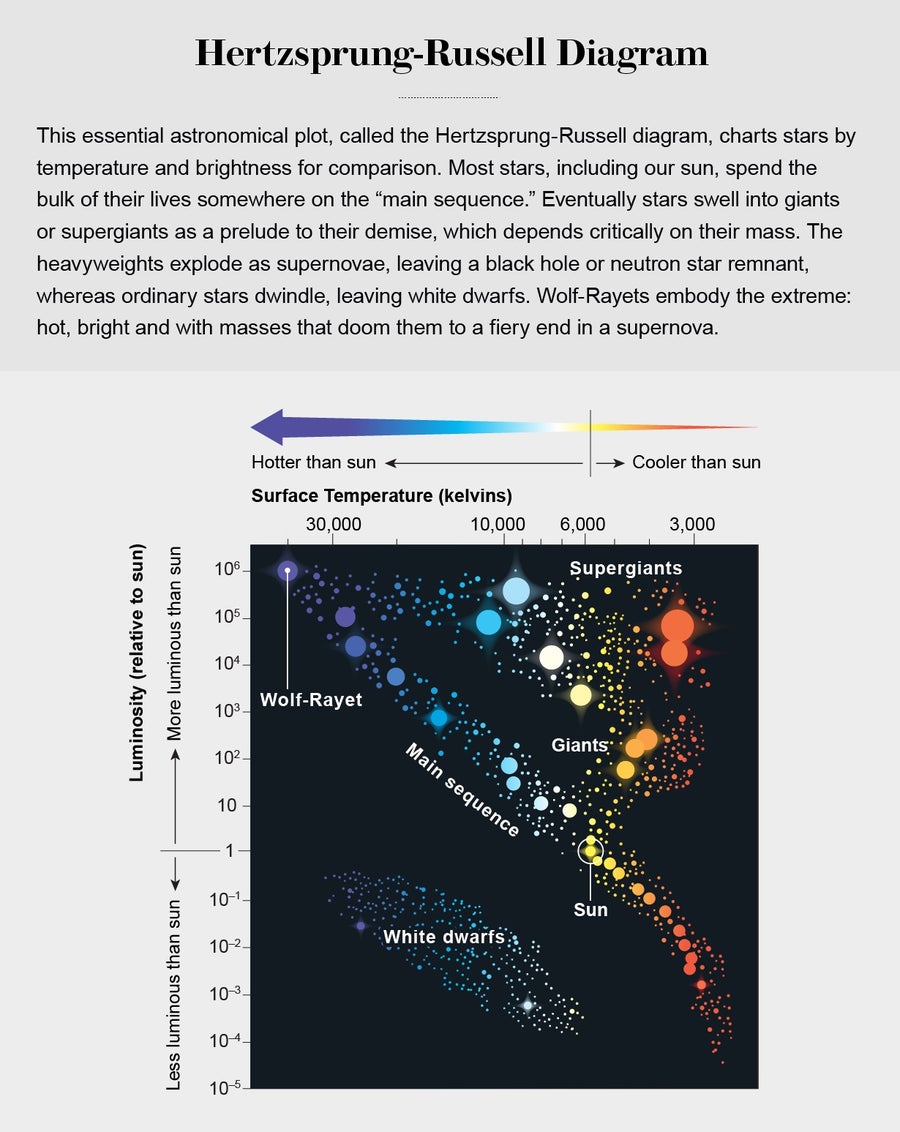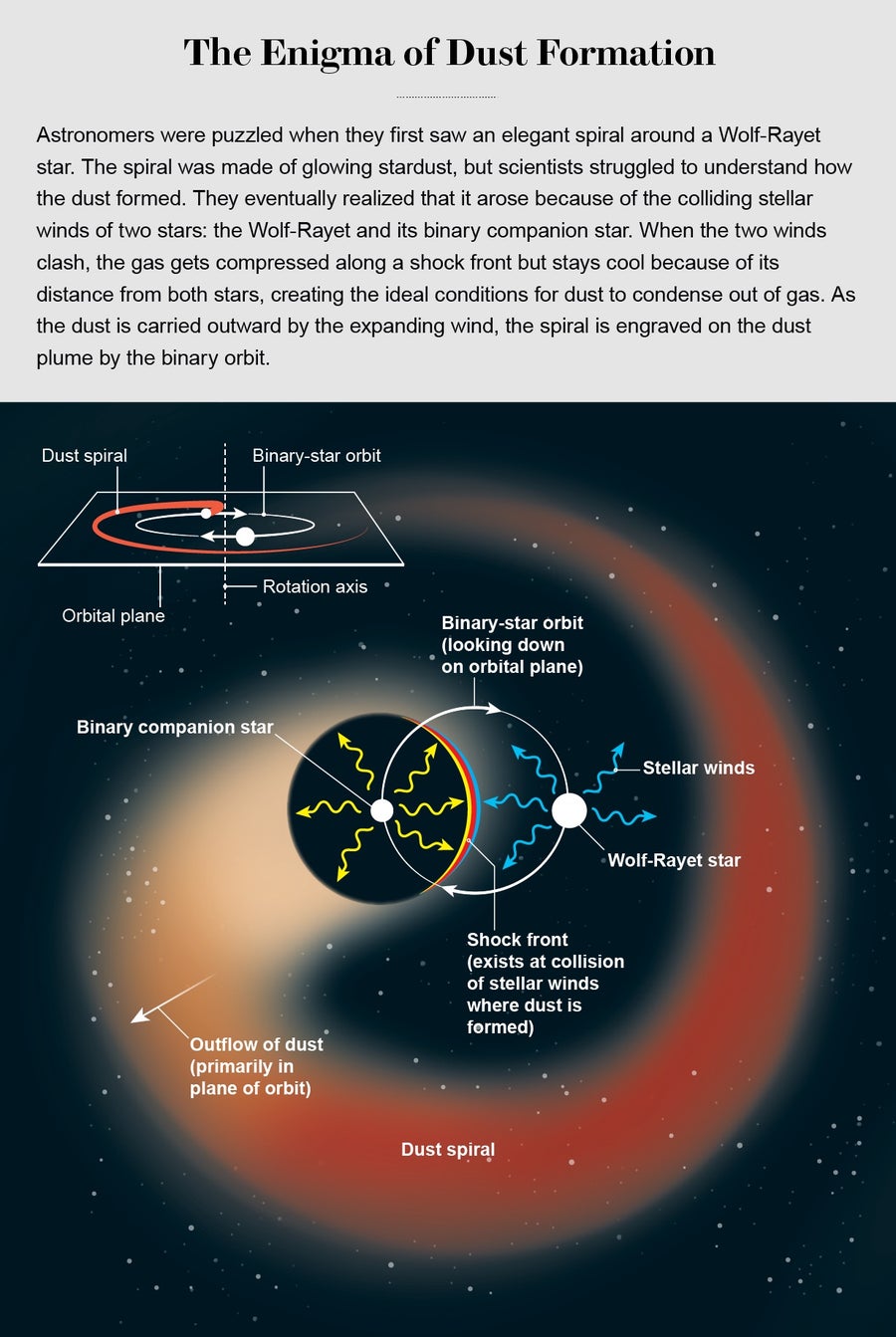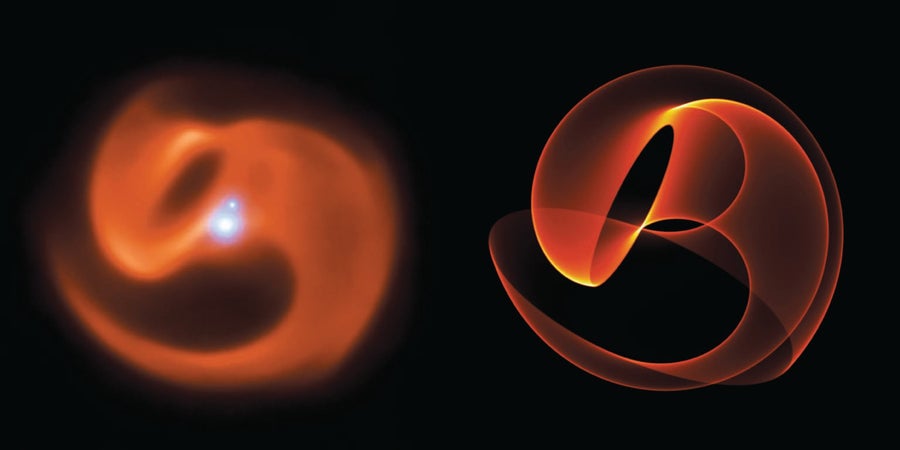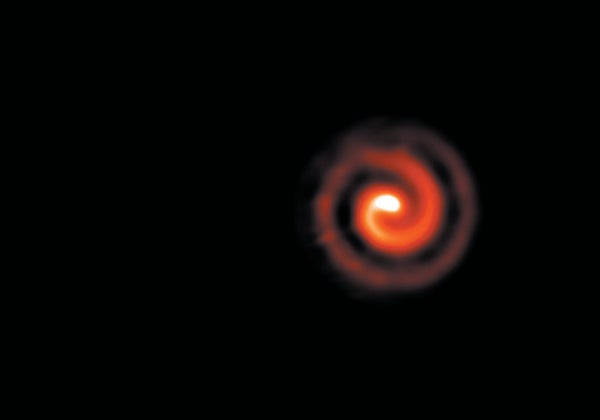天文学家在谈论被称为 沃尔夫-拉叶星的极其炽热和明亮的恒星时,往往会用尽赞美之词,这些恒星是宇宙中最大、最热和最稀有的恒星之一。沃尔夫-拉叶星被认为是质量最大的恒星生命中最后、短暂的阶段——这些恒星的初始质量是太阳质量的 20 倍到 200 多倍不等。这些庞然大物是蓝色的,并且非常明亮,它们以“活得快,死得早”的姿态迅速燃烧掉大量的氢燃料储备。当它们燃烧殆尽时,它们会以惊人的速度喷射出大量稠密、快速的星风。当它们的燃料耗尽时,这些恒星会在自身引力作用下坍缩,形成我们观测到的灾难性事件——超新星。
它们的极端性质使它们成为天体界的异类,聚集在天文学基础图表——赫罗图的边缘,该图表根据恒星的亮度和温度对恒星进行mapping。 沃尔夫-拉叶星 超越了图表的“主序星”,普通恒星聚集于此。它们是表面温度可能超过 200,000 开尔文(比太阳热 30 倍)的膨胀怪物,其辐射场的光度可能是太阳的百万倍以上。

来自詹姆斯·韦伯太空望远镜的红外图像(左)显示了 WR 140 恒星系统周围奇特的尘埃波纹。这张照片与数值模拟(右)非常吻合,后者描绘了 15 个连续的尘埃壳,这些尘埃壳在与该系统八年双星轨道相吻合的时间间隔内喷射出来。鸣谢:NASA/ESA/CSA/STScI/Lau et al., 2022 (左);Shashank Dholakia/Peter Tuthill (左图像处理); Yinuo Han/Peter Tuthill (右)
关于支持科学新闻报道
如果您喜欢这篇文章,请考虑通过以下方式支持我们屡获殊荣的新闻报道: 订阅。通过购买订阅,您正在帮助确保有关当今塑造我们世界的发现和想法的具有影响力的故事的未来。
沃尔夫-拉叶星的 defining 特征——氢的低丰度——结果证明是厄运的先兆。当恒星耗尽氢后,它将开始燃烧其他燃料,例如氦,但这只会为恒星赢得短暂的喘息之机。沃尔夫-拉叶星的寿命以百万年甚至更短的时间来衡量。与太阳 100 亿年的寿命相比,这只是眨眼之间。而且由于大质量恒星在恒星类型中已经属于例外,因此沃尔夫-拉叶星更加稀有:它们实际上是十亿分之一的恒星。尽管它们的亮度使望远镜很容易找到它们,但我们只知道银河系中只有几百颗。
尽管这些神秘的恒星非常稀有,但它们与当今最紧迫的天文问题有着纠缠的历史。随着来自 詹姆斯·韦伯太空望远镜等强大设施的更多观测结果的到来,这种趋势正在重演。最近,沃尔夫-拉叶星向我们提出了关于驱动它们的物理学的新问题,这可能有助于解决关于恒星的性质和命运的重大谜团。
谜团诞生
1876 年,当法国天文学家查尔斯·沃尔夫和乔治·拉叶首次对天鹅座中的三颗恒星感到困惑时,光谱学——通过将天文物体的光分散成其组成颜色来研究天文物体——的科学还处于起步阶段。尽管如此,沃尔夫和拉叶已经见过足够多的普通恒星,知道正在发生一些非常奇怪的事情。像太阳这样的普通恒星的光谱由来自整个可见颜色范围的光组成,上面印有分散的、细窄的暗线,这些暗线代表恒星中化学元素吸收的波长。天鹅座中的新恒星似乎完全是另一回事:它们显示出鲜艳的彩色 bands,“更让人联想到星云”,天文学家写道,这使他们推测这些恒星可能“主要将其亮度归功于炽热的蒸汽”。
在接下来的几十年里,天文学家开始更好地理解大多数恒星类型的光谱,但沃尔夫-拉叶星仍然是一种 incomprehensible 的怪异现象。它们偶尔会吸引像拉尔夫·科普兰这样的科学家。1884 年,他带领探险队前往秘鲁高海拔的的喀喀湖岸边,天文设备由骡子队运送。在那里,他偶然发现了 γ 船帆座星(“gamma Argus”,现在称为 γ Velorum),其“蓝色中 intensely bright 的线条和黄色和橙色中 gorgeous 的三条 bright 线条使其光谱成为整个天空中 incomparably 最 brilliant 和 striking 的光谱”。科普兰被迷住了:“这种光谱的 extraordinary beauty … 促使我花费相当一部分时间对银河系附近进行或多或少的 systematic sweeps”。他最终又 netted 了五颗类似的恒星。尽管没有一颗像 γ Velorum 那样 spectacular,但这项努力使已知的沃尔夫-拉叶星目录增加了一倍以上。

鸣谢:Sayo Studio
半个世纪以来,沃尔夫-拉叶现象仍然是“一扇尚未打开的门,而且钥匙非常 curious,以至于我们甚至不确定如何将其插入锁中”,正如美国天文学家唐纳德·H·门泽尔在 1929 年写道的那样。但在 20 世纪 30 年代,各种研究逐渐理解了恒星背后的物理学原理。沃尔夫和拉叶关于“炽热蒸汽”的评论一直都是正确的,但天文学家一直不愿将物理条件 dial up 到 mind-boggling 的 levels。
沃尔夫-拉叶星中 searing 的温度在恒星表面 fuel 了如此强大的辐射场,以至于光本身也成为一种不可忽视的力量。任何天体物体的 luminosity 都有一个 fundamental 上限,超过这个上限,“观测到的发射辐射……会 blow up 恒星”,亚瑟·爱丁顿在 1926 年一篇 influential 的论文中写道。事实证明,沃尔夫-拉叶星非常 luminous,以至于它们 flirt with 这个“爱丁顿极限”,导致它们的表面层不断被恒星的 incandescent glare 驱动脱落。打开门泽尔之门的 key 结果证明是这种强大的 stellar wind,以每秒数千公里的速度 streaming——约为光速的 1%。有时会使用“solar hurricane”这个词,但这种与太阳 solar wind 的比较并不能 remotely do it justice。想象一下,在平静的日子里最轻微的 discernible breath of air 与 powerful water cannon 的力量相比。我们太阳的 solar wind 与沃尔夫-拉叶星 solar wind 之间的 divergence 超过了这个 ratio 10,000 倍以上。
即使是 tiny handful 的这些 overachievers 也能 profoundly impact 整个星系的 ecosystem。 Streaming winds 将能量、动量和新形成的元素带入恒星之间的 voids,blowing bubbles,compressing clouds 和 heating gas。沃尔夫-拉叶星对银河系平衡的最重要贡献是最 least expected 的:stardust。 Dust——tiny flakes of star stuff——在星系物质 grand cycle 中起着各种 crucial 的 roles,也许 most of all 通过 shielding 和 cooling 整个星系的气体,使其 condense 以形成新 generations of stars。然而,天文学家一直在 struggle to account for 他们看到的所有 dust。在 astronomy 中,dust 有点像 snow:plentiful 在 calm conditions 和 cool climates 中。 last place to expect dust creation 是 somewhere bathed 在 hot, harsh ultraviolet radiation surrounding 沃尔夫-拉叶星周围。

鸣谢:Sayo Studio
如何在 hell 中形成 snowflakes 的 conundrum 仅在发现名为 WR 140 的 miraculous 系统后才得到解决。在 20 世纪 80 年代,由爱丁堡皇家天文台的 Peredur Williams 领导的团队发现,这颗恒星产生的 dust 以 pulses 形式出现,spaced 八年 apart。这一发现 immediately linked 了 dust 的 creation 到与沃尔夫-拉叶星共同 orbit 的 binary companion 的八年 period。这个 companion 是另一颗 luminous blue star,位于 elliptical orbit 上。在这个 binary system 中,天文学家 realized,dust 在这对星进行 closest approach 时形成。当来自沃尔夫-拉叶星的 wind 与 massive companion 的 wind collide 和 entangles 时,两者互相 fight each other to a standstill。在这里,cool, calm conditions just right for dust to condense out of the gas。这种 colliding-wind dust mechanism requires 两颗恒星都 launch powerful winds——a condition that can be met 因为 massive stars 经常 form along with similarly massive companions。
与 WR 140 不同,许多其他沃尔夫-拉叶星 continuously pump out dust,apparently with no regard for 它们 orbit 的 timing。 Figuring out why,以及 continuous dust makers 是否与 clockwork dust-created-each-orbit variety differently work,became a key question for 我 own research。
风车
在 20 世纪 90 年代中期,我与当时的 student John D. Monnier 在加利福尼亚州诺贝尔奖获得者查尔斯·H·汤斯的小组中工作。夏威夷巨型凯克望远镜刚刚开业。然而,要 understand 沃尔夫-拉叶星 dust formation,我们需要 sharp images revealing a level of detail,这超出了 even 凯克巨大的 10 米镜子的 capability。 Today we could just switch on an adaptive optics system——现在是 standard equipment,可以 counteract 地球大气层的 shimmering。但在 20 世纪 90 年代,能够 image 我们沃尔夫-拉叶星的 technology 还需要 tens of years 和 many millions of dollars 在未来。

鸣谢:Sayo Studio
Necessity being the mother of invention,我们 had no option but to think laterally。我们 secured 了一个大型金属 mask,大约 trash can lid 的 size,上面 carefully arranged perforated holes,to 其中一个凯克望远镜。通过 blocking much of the starlight,我们 transformed 主镜 into an array of small collectors,allowing 凯克 to work much like modern radio telescopes,将许多 smaller antennas 连接在一起。 image fidelity 的 gains exceeded 我们 wildest dreams。整个 performance requires climbing onto the telescope to swap out masks 在 night while perched 在 observatory floor 以上 15 米处,这 something 我 am eternally surprised they ever let us get away with。
Forming images using this technique requires significant computer processing,plus a lot of custom code。当我们 first beheld 我们 most important 沃尔夫-拉叶星 target,一颗 designated WR 104 的恒星,在 computer monitor 上,它是一个 shimmering spiral,resembled 一个 weirdly distorted Christmas bauble。我 looked at John and groaned,“Never heard of any star shaped like a spiral。 How did we get a bug in the code to produce that kind of error?” 我们 went back and improved the code,但 spiral stayed put。 It was not until a few months later,when data from a second visit to the 凯克 telescope produced another spiral,that 我们 accepted reality。 New image was almost the same spiral shape as before but rotated by about 90 degrees。 Spiral was real,and furthermore,we had a moving target on 我们 hands。
Hindsight being what it is,我 understand now that a spiral is exactly what we should have been looking for all along。 What confused us was that dust needs dense, cool gas to form。 沃尔夫-拉叶星 can meet only one of these conditions at any given spot:close to the star the gas is dense but hot,whereas far away it is cool but too tenuous。 This is where binary pair comes in。 当来自两颗恒星的 winds collide 时,gas compresses far enough away from the stars for it to stay cool——conditions leading to a “dust nursery”。 Dust grains condense out of the gas along a bowl-shaped “shell” where the winds clash。 As the stars orbit and their expanding winds sweep outward,dust spirals out like the jet from a lawn sprinkler。
The result of all this physics manifests as a majestic spiral plume。 To the eye of an astrophysicist,however,beauty is deeper。 These structures open a rare window into phenomena we could otherwise never hope to witness。 It's as if nature writes its secrets in a script too tiny to see,but then the expanding wind inflates the text into a giant banner。 Here were the properties of the winds,the stars that launched them and parameters of their orbital dance,laid out for us to read。 WR 104 became the prototype for a new class of nebulae that we christened “pinwheels”。 We soon found more systems,given names like WR 112 and WR 98a,that shared a common architecture,yet each was unique and distinctly beautiful。
一个新的谜团
在随后的几年里,风车 continued to fascinate,beguile 和 confound 我们。
One ongoing puzzle began back in 1963,when 美国和苏联之间的 Partial Test Ban Treaty came into force,prompting 美国 to launch Vela satellites to monitor compliance by sensing gamma rays given off by nuclear tests。 The sensors onboard these satellites began reporting events coming from above,not just below。 These so-called gamma-ray bursts have since become one of the hottest topics in astronomy。 A subtype of longer-duration bursts,which last more than two seconds,are thought to arise from supernovae marking the deaths of 沃尔夫-拉叶星。
Not only are gamma-ray bursts intriguing,but over cosmic time they may even pose a safety risk。 Typical supernovae can really affect only their immediate stellar neighborhood。 This may not be true of gamma-ray-burst supernovae。 Here the energy output is confined to a narrow and powerful beam,so with the right alignment they are visible at vast cosmic distances。 Such an alignment for a nearby event may herald danger。

一系列图像显示了 WR 104 系统中 dust spiral 的 motion,它在 sky 上 spins over 一个八个月 orbital cycle 的 duration。 鸣谢:W. M. 凯克天文台/彼得·图希尔 (model series)
Speculative studies have suggested that events in Earth's fossil record,such as the Late 奥陶纪大灭绝,could have been caused by a gamma-ray-burst strike。 The risk of such a cataclysm exists only when Earth is situated exactly along the line of the burst。 For the first time 我们 data allowed us to analyze the likely axis of a possible future burst from 我们 pinwheel 沃尔夫-拉叶星。 Unfortunately,WR 104 might be pointing 我们 way。
Yet the statistical threat posed by a future gamma-ray strike from WR 104 is truly minuscule:several very unlikely things would have to happen all in sequence,including the low-probability event WR 104 can host a gamma-ray burst (rather than a typical supernova) in the first place。 When writing up 我们 research,my colleagues and I weighed the vanishingly small but nonzero odds—and the fact humanity faces more serious threats from things such as climate change—and decided to include only a few short, carefully worded sentences on this possibility in 我们 paper。 Of course,these lines immediately went viral on the Internet。 Soon I was in my department head's office,explaining how I'd become famous for 2012 end-of-the-world Mayan calendar conspiracy theories。
More recently,we've recovered spectacular new data on the pinwheels from observatories such as 詹姆斯·韦伯太空望远镜,the likes of which 沃尔夫 and 拉叶 could hardly have imagined 150 years ago。 Among the very first JWST images was a revelatory vision of an old friend,WR 140 (of the eight-year dust cycle mentioned earlier)。

猿神星三合星系统,在红外线下看到(左),喷射出 sculpted plume of hot dust around 它。 A computer simulation of the dust (右) can reproduce much of the complex structure in 猿神星’s shell。 鸣谢: ESO/Callingham et al., 1999 (左); Yinuo Han/Peter Tuthill (右)
With the staggering leap in sensitivity from this new observatory,we can see shell after shell of dust—nearly 20 of them marching out into space,each an exquisitely sculpted replica nested within the older, more inflated one preceding it。 My student Yinuo Han and I compared this observation with a previous computer model we'd built to describe only WR 140's single innermost dust shell。 When we extrapolated out to see what 150 years of repeat shells might look like,our result almost perfectly mimicked the onion-layer image from JWST,showing the uncanny power of mathematics to echo the real world。
Perhaps the most exciting of the new discoveries has been the first confirmed twin 沃尔夫-拉叶星 binary,a system called Apep,which my colleagues and I named after the mortal enemy of Egyptian sun god Ra。 Images of the system evoke the mythology,suggesting a star embattled within a serpent's coils。 Apep also offers a surprise。 Our calculations clock the speed of 沃尔夫-拉叶星's expanding gas wind,as well as the expansion rate of the dust。 These two numbers should agree,and for all the other pinwheels,they do。 In Apep,however,the dust streams out only one third as fast as the gas yet is caught in the teeth of the strongest howling gale known to stellar physics。 It's like finding a feather adrift in a hurricane,somehow floating along at its own gentle pace。 How does dust around Apep perform this magic trick? Nobody knows for sure。
Once again,沃尔夫-拉叶星 are humbling astronomers who think they understand how things work。 And by the time we have the answer to this question,I'm sure these enigmatic stars will have given us still deeper mysteries。 They have a history of mixing things up every time they make an appearance。

